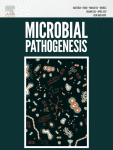Ver ítem
- xmlui.general.dspace_homeCentros Regionales y EEAsCentro Regional Santa FeEEA RafaelaArtículos científicosxmlui.ArtifactBrowser.ItemViewer.trail
- Inicio
- Centros Regionales y EEAs
- Centro Regional Santa Fe
- EEA Rafaela
- Artículos científicos
- Ver ítem
Assessment of the potential utility of different regions of Streptococcus uberis adhesion molecule (SUAM) for mastitis subunit vaccine development
Resumen
Streptococcus uberis is one of the most prevalent pathogens causing clinical and subclinical mastitis
worldwide. Among bacterial factors involved in intramammary infections caused by this organism,
S. uberis adhesion molecule (SUAM) is one of the main virulence factors identified. This molecule is
involved in S. uberis internalization to mammary epithelial cells through lactoferrin (Lf) binding. The
objective of this study was to evaluate SUAM
[ver mas...]
Streptococcus uberis is one of the most prevalent pathogens causing clinical and subclinical mastitis
worldwide. Among bacterial factors involved in intramammary infections caused by this organism,
S. uberis adhesion molecule (SUAM) is one of the main virulence factors identified. This molecule is
involved in S. uberis internalization to mammary epithelial cells through lactoferrin (Lf) binding. The
objective of this study was to evaluate SUAM properties as a potential subunit vaccine component for
prevention of S. uberis mastitis. B epitope prediction analysis of SUAM sequence was used to identify
potentially immunogenic regions. Since these regions were detected all along the gene, this criterion did
not allow selecting a specific region as a potential immunogen. Hence, four fractions of SUAM (-1fr, 2fr,
3fr and 4fr), comprising most of the protein, were cloned and expressed. Every fraction elicited a humoral
immune response in mice as predicted by bioinformatics analysis. SUAM-1fr generated antibodies with
the highest recognition ability towards SUAM native protein. Moreover, antibodies against SUAM-1fr
produced the highest proportion of internalization inhibition of S. uberis to mammary epithelial cells.
In conclusion, SUAM immunogenic and functionally relevant regions were identified and allowed to
propose SUAM-1fr as a potential candidate for a subunit vaccine for S. uberis mastitis prevention.
[Cerrar]

Autor
Perrig, Melina Soledad;
Veaute, Carolina Melania Isabel;
Renna, María Sol;
Pujato, Nazarena;
Calvinho, Luis Fernando;
Marcipar, Ivan Sergio;
Barbagelata, Maria Sol;
Fuente
Microbial pathogenesis 105 : 273-279. (April 2017)
Fecha
2017-04
ISSN
0882-4010 (Print)
1096-1208 (Online)
1096-1208 (Online)
Formato
pdf
Tipo de documento
artículo
Palabras Claves
Derechos de acceso
Restringido
 Excepto donde se diga explicitamente, este item se publica bajo la siguiente descripción: Creative Commons Attribution-NonCommercial-ShareAlike 2.5 Unported (CC BY-NC-SA 2.5)
Excepto donde se diga explicitamente, este item se publica bajo la siguiente descripción: Creative Commons Attribution-NonCommercial-ShareAlike 2.5 Unported (CC BY-NC-SA 2.5)

